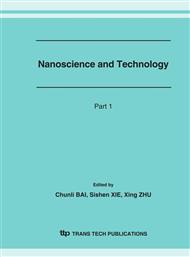[1]
N. De Jonge and J.M. Bonard: Phil. Trans. R. Soc. Lond. A 362 (2004), 2239.
Google Scholar
[2]
D. Banerjee, S.H. Jo and Z.F. Ren: Adv. Mater. 16 (2004), (2028).
Google Scholar
[3]
Z. Pan, H. -L. Lai, F.C.K. Au, X. Duan, W. Zhou, W. Shi, N. Wang, C. -S. Lee, N. -B. Wong, S. -T. Lee and S. Xie: Adv. Mater. 12 (2000), 1186.
Google Scholar
[4]
J. Zhou, N.S. Xu, S.Z. Deng, J. Chen, J.C. She and Z.L. Wang: Adv. Mater. 15 (2003), 1835.
Google Scholar
[5]
L. Vila, P. Vincent, L.D. -De Pra, G. Pirio, E. Minoux, L. Gangloff, S.D. -Champagne, N. Sarazin, E. Ferain, R. Legras, L. Piraux and P. Legagneu: Nano Lett. 4 (2004), 521.
DOI: 10.1021/nl0499239
Google Scholar
[6]
J. Liu, Z. Zhang, Y. Zhao, X. Su, S. Liu and E. Wang: Small 1 (2005), 310.
Google Scholar
[7]
J. Xu, J. Mei, X.H. Huang, X. Li, Z. Li, W. Li and K. Chen: Appl. Phys. A 80 (2005), 123.
Google Scholar
[8]
O. Yavas, N. Suzuki, M. Takai, A. Hosono and S. Kawabuchi: Appl. Phys. Lett. 72 (1998), 2797.
DOI: 10.1063/1.121461
Google Scholar
[9]
W.M. Tsang, S.P. Wong and J.K.N. Lindner: Appl. Phys. Lett. 84 (2004), 3193.
Google Scholar
[10]
W. Yi, T. Jeong, S.G. Yu, J. Heo, C. Lee, J. Lee, W. Kim, J. -B. Yoo and J. Kim: Adv. Mater. 14 (2002), 1464.
Google Scholar
[11]
C.Y. Zhi, X.D. Bai, and E.G. Wang: Appl. Phys. Lett. 81 (2002), 1690.
Google Scholar
[12]
C. -H. Hsu, H. -C. Lo, C. -F. Chen, C. T. Wu, J. -S. Hwang, D. Das, J. Tsai, L. -C. Chen and K. -H. Chen: Nano Lett. 4 (2004), 471.
Google Scholar
[13]
I.W. Rangelow: Microelectronics Engineering 23 (1994), 369.
Google Scholar
[14]
F.C.K. Au, K.W. Wong, Y.H. Tang, Y.F. Zhang, I. Bello and S.T. Lee: Appl. Phys. Lett. 75(1999), 1700.
Google Scholar
[15]
X.C. Jiang, T. Herricks and Y.N. Xia: Nano Lett. 2 (2002), 1333.
Google Scholar
[16]
Y.W. Zhu, T. Yu, F.C. Cheong, X.J. Xu, C.T. Lim, V.B.C. Tan, J.T.L. Thong and C.H. Sow: Nanotechnology 16 (2005), 88.
Google Scholar
[17]
Y.W. Zhu, F.C. Cheong, T. Yu, X.J. Xu, C.T. Lim, J.T.L. Thong, Z.X. Shen, C.K. Ong, Y.J. Liu, A.T.S. Wee and C.H. Sow: Carbon 43 (2005), 395.
DOI: 10.1016/j.carbon.2004.09.029
Google Scholar
[18]
K.Y. Lim, C.H. Sow, J. Lin, F.C. Cheong, Z.X. Shen, J.T.L. Thong, K.C. Chin and A.T.S. Wee: Adv. Mater. 15 (2003), 300.
DOI: 10.1002/adma.200390072
Google Scholar
[19]
R.C. Che, L.M. Peng and M.S. Wang: Appl. Phys. Lett. 85 (2004), 4753.
Google Scholar
[20]
Y.Z. Jin, W.K. Hsu, Y.L. Chueh, L.J. Chou, Y.Q. Zhu, K. Brigatti, H.W. Kroto and D.R.M. Walton: Angew. Chem. Int. Ed. 43 (2004), 5670.
DOI: 10.1002/anie.200460447
Google Scholar
[21]
W. Hu, M. Matsumura, K. Furukawa and K. Torimitsu: J. Phys. Chem. B 108 (2004), 13116.
Google Scholar
[22]
G.V. Chertihin, L. Andrews and C.W. Bauschlicher: J. Phys. Chem. B 101 (1997), 4026.
Google Scholar


